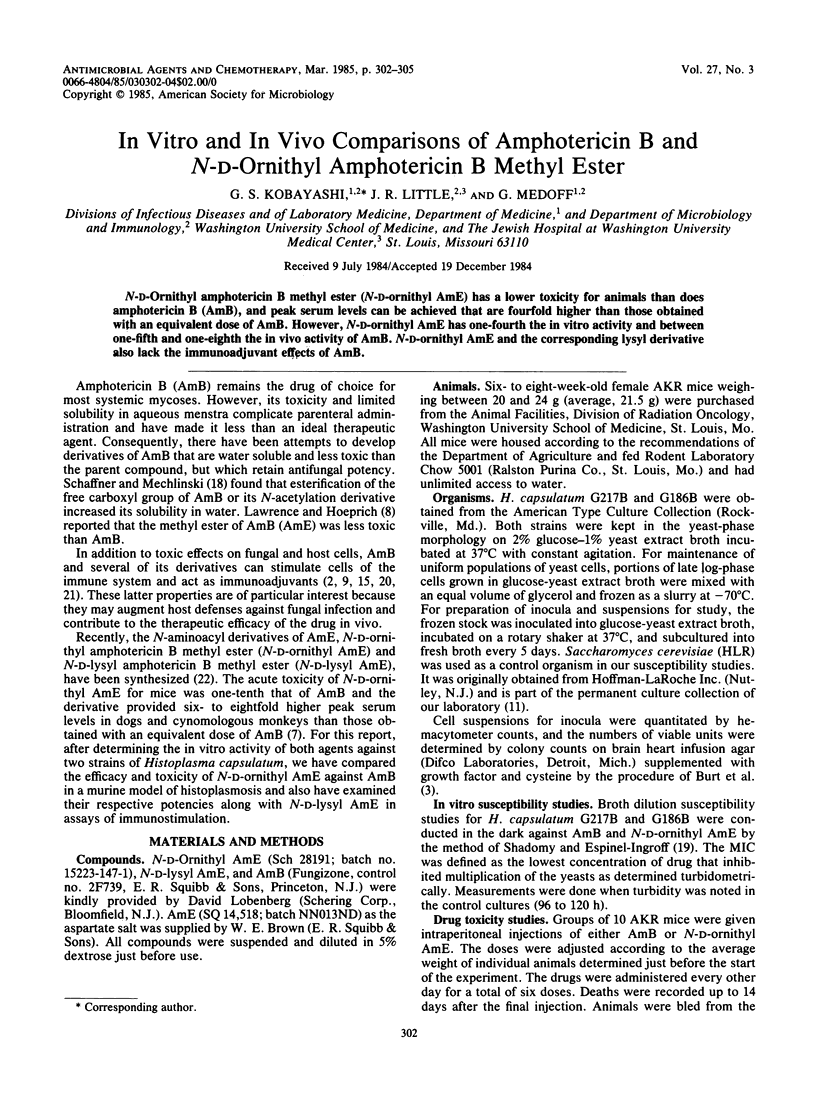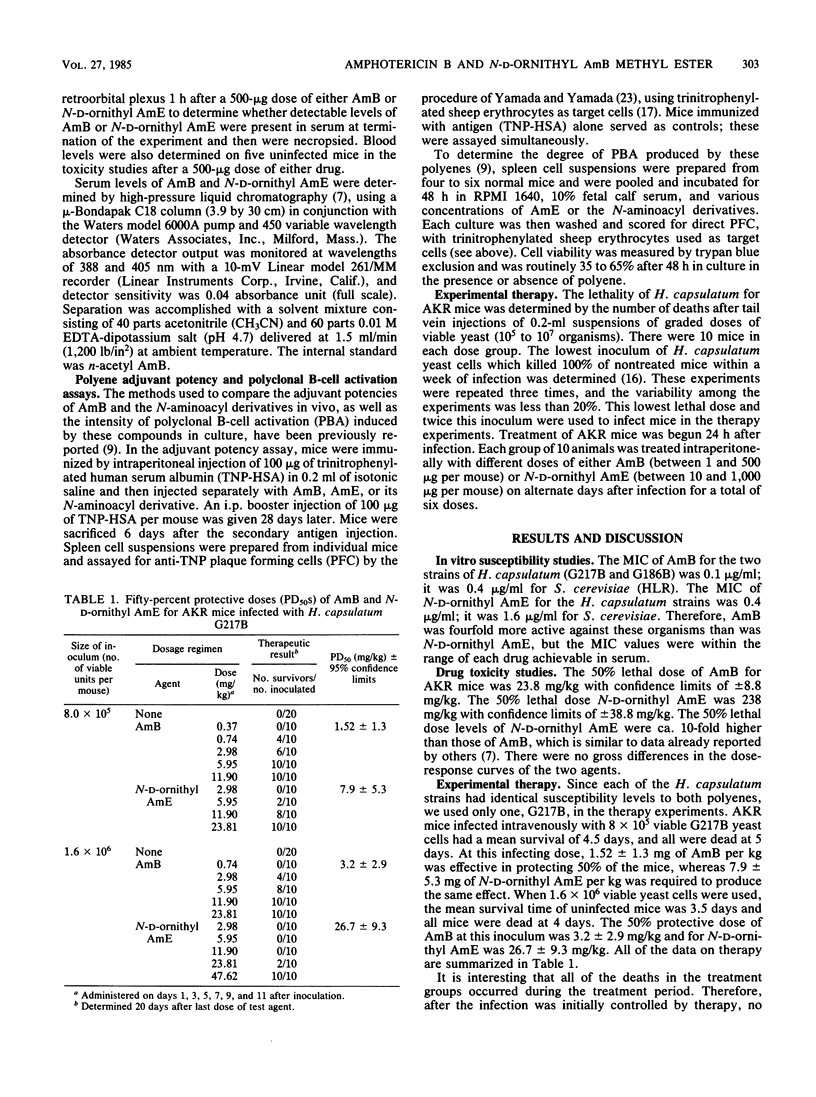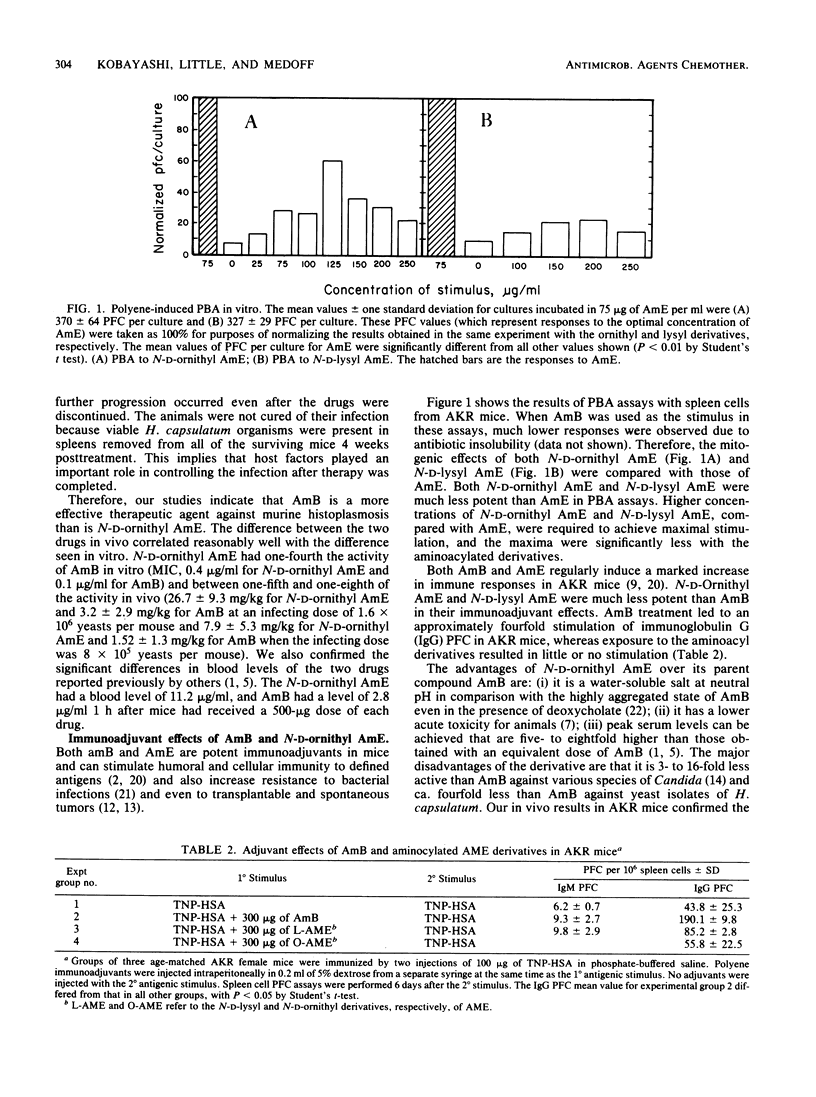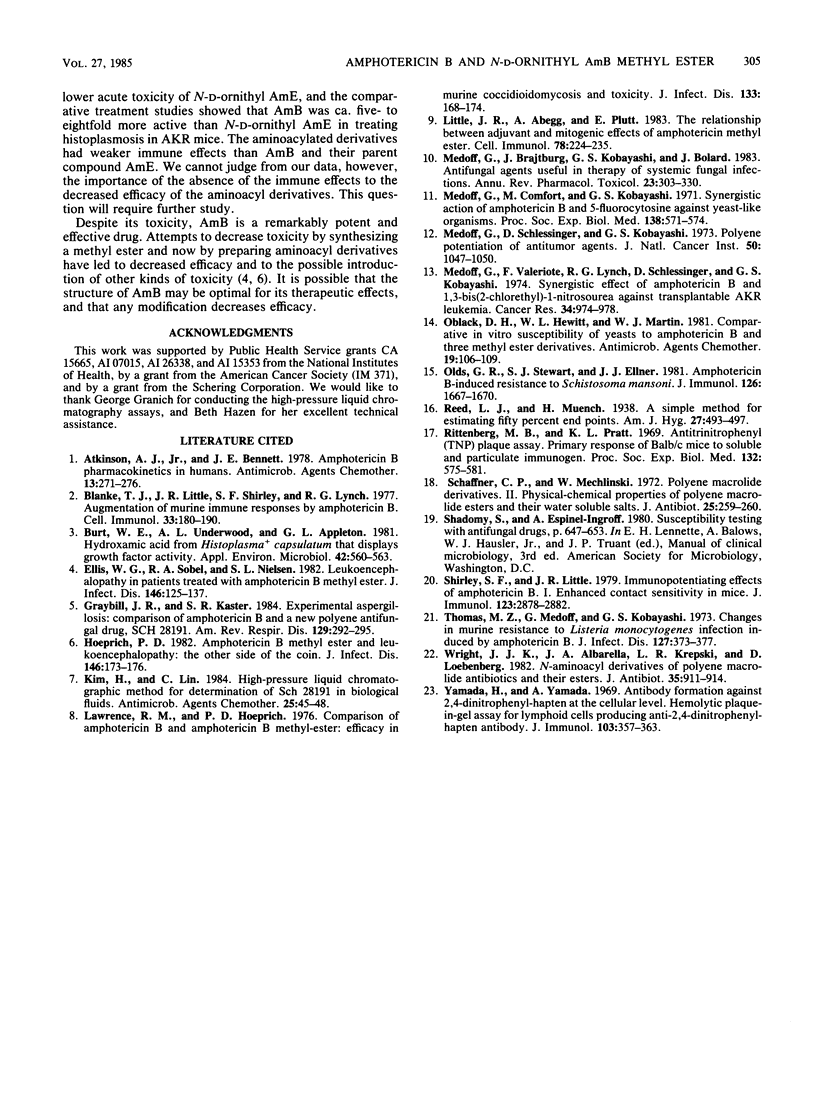Abstract
N-D-Ornithyl amphotericin B methyl ester (N-D-ornithyl AmE) has a lower toxicity for animals than does amphotericin B (AmB), and peak serum levels can be achieved that are fourfold higher than those obtained with an equivalent dose of AmB. However, N-D-ornithyl AmE has one-fourth the in vitro activity and between one-fifth and one-eighth the in vivo activity of AmB. N-D-ornithyl AmE and the corresponding lysyl derivative also lack the immunoadjuvant effects of AmB.
Full text
PDF



Selected References
These references are in PubMed. This may not be the complete list of references from this article.
- Atkinson A. J., Jr, Bennett J. E. Amphotericin B pharmacokinetics in humans. Antimicrob Agents Chemother. 1978 Feb;13(2):271–276. doi: 10.1128/aac.13.2.271. [DOI] [PMC free article] [PubMed] [Google Scholar]
- Blanke T. J., Little J. R., Shirley S. F., Lynch R. G. Augmentation of murine immune responses by amphotericin B. Cell Immunol. 1977 Sep;33(1):180–190. doi: 10.1016/0008-8749(77)90145-9. [DOI] [PubMed] [Google Scholar]
- Burt W. R., Underwood A. L., Appleton G. L. Hydroxamic acid from Histoplasma capsulatum that displays growth factor activity. Appl Environ Microbiol. 1981 Sep;42(3):560–563. doi: 10.1128/aem.42.3.560-563.1981. [DOI] [PMC free article] [PubMed] [Google Scholar]
- Ellis W. G., Sobel R. A., Nielsen S. L. Leukoencephalopathy in patients treated with amphotericin B methyl ester. J Infect Dis. 1982 Aug;146(2):125–137. doi: 10.1093/infdis/146.2.125. [DOI] [PubMed] [Google Scholar]
- Graybill J. R., Kaster S. R. Experimental murine aspergillosis. Comparison of amphotericin B and a new polyene antifungal drug, SCH 28191. Am Rev Respir Dis. 1984 Feb;129(2):292–295. [PubMed] [Google Scholar]
- Hoeprich P. Amphotericin B methyl ester and leukoencephalopathy: the other side of the coin. J Infect Dis. 1982 Aug;146(2):173–176. doi: 10.1093/infdis/146.2.173. [DOI] [PubMed] [Google Scholar]
- Kim H., Lin C. High-pressure liquid chromatographic method for determination of Sch 28191 in biological fluids. Antimicrob Agents Chemother. 1984 Jan;25(1):45–48. doi: 10.1128/aac.25.1.45. [DOI] [PMC free article] [PubMed] [Google Scholar]
- Lawrence R. M., Hoeprich P. D. Comparison of amphotericin B and amphotericin B methyl ester: efficacy in murine coccidioidomycosis and toxicity. J Infect Dis. 1976 Feb;133(2):168–174. doi: 10.1093/infdis/133.2.168. [DOI] [PubMed] [Google Scholar]
- Little J. R., Abegg A., Plut E. The relationship between adjuvant and mitogenic effects of amphotericin methyl ester. Cell Immunol. 1983 Jun;78(2):224–235. doi: 10.1016/0008-8749(83)90277-0. [DOI] [PubMed] [Google Scholar]
- Medoff G., Brajtburg J., Kobayashi G. S., Bolard J. Antifungal agents useful in therapy of systemic fungal infections. Annu Rev Pharmacol Toxicol. 1983;23:303–330. doi: 10.1146/annurev.pa.23.040183.001511. [DOI] [PubMed] [Google Scholar]
- Medoff G., Comfort M., Kobayashi G. S. Synergistic action of amphotericin B and 5-fluorocytosine against yeast-like organisms. Proc Soc Exp Biol Med. 1971 Nov;138(2):571–574. doi: 10.3181/00379727-138-35943. [DOI] [PubMed] [Google Scholar]
- Medoff G., Schlessinger D., Kobayashi G. S. Brief communication: polyene potentiation of antitumor agents. J Natl Cancer Inst. 1973 Apr;50(4):1047–1050. doi: 10.1093/jnci/50.4.1047. [DOI] [PubMed] [Google Scholar]
- Medoff G., Valeriote F., Lynch R. G., Schlessinger D., Kobayashi G. S. Synergistic effect of amphotericin B and 1,3-bis(2-chloroethyl)-1-nitrosourea against a transplantable AKR leukemia. Cancer Res. 1974 May;34(5):974–978. [PubMed] [Google Scholar]
- Oblack D. L., Hewitt W. L., Martin W. J. Comparative in vitro susceptibility of yeasts to amphotericin B and three methyl ester derivatives. Antimicrob Agents Chemother. 1981 Jan;19(1):106–109. doi: 10.1128/aac.19.1.106. [DOI] [PMC free article] [PubMed] [Google Scholar]
- Olds G. R., Stewart S. J., Ellner J. J. Amphotericin B-induced resistance to Schistosoma mansoni. J Immunol. 1981 May;126(5):1667–1670. [PubMed] [Google Scholar]
- Rittenberg M. B., Pratt K. L. Antitrinitrophenyl (TNP) plaque assay. Primary response of Balb/c mice to soluble and particulate immunogen. Proc Soc Exp Biol Med. 1969 Nov;132(2):575–581. doi: 10.3181/00379727-132-34264. [DOI] [PubMed] [Google Scholar]
- Schaffner C. P., Mechlinski W. Polyene macrolide derivatives. II. Physical-chemical properties of polyene macrolide esters and their water soluble salts. J Antibiot (Tokyo) 1972 Apr;25(4):259–260. [PubMed] [Google Scholar]
- Shirley S. F., Little J. R. Immunopotentiating effects of amphotericin B. I. Enhanced contact sensitivity in mice. J Immunol. 1979 Dec;123(6):2878–2882. [PubMed] [Google Scholar]
- Thomas M. Z., Medoff G., Kobayashi G. S. Changes in murine resistance to Listeria monocytogenes infection induced by amphotericin B. J Infect Dis. 1973 Apr;127(4):373–377. doi: 10.1093/infdis/127.4.373. [DOI] [PubMed] [Google Scholar]
- Wright J. J., Albarella J. A., Krepski L. R., Loebenberg D. N-aminoacyl derivatives of polyene macrolide antibiotics and their esters. J Antibiot (Tokyo) 1982 Jul;35(7):911–914. doi: 10.7164/antibiotics.35.911. [DOI] [PubMed] [Google Scholar]
- Yamada H., Yamada A. Antibody formation against 2,4-dinitrophenyl-hapten at the cellular level. Hemolytic plaque-in-gel assay for lymphoid cells producing anti-2,4-dinitrophenyl-hapten antibody. J Immunol. 1969 Aug;103(2):357–363. [PubMed] [Google Scholar]


